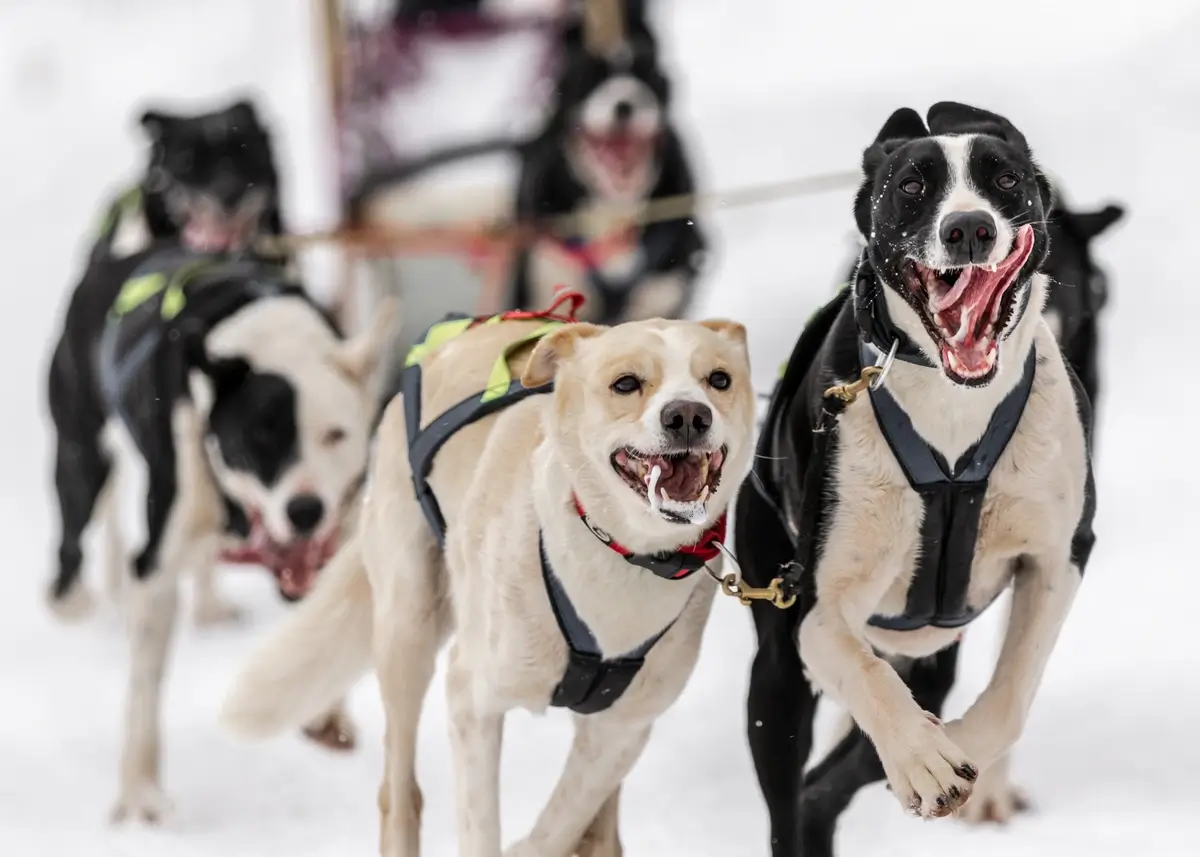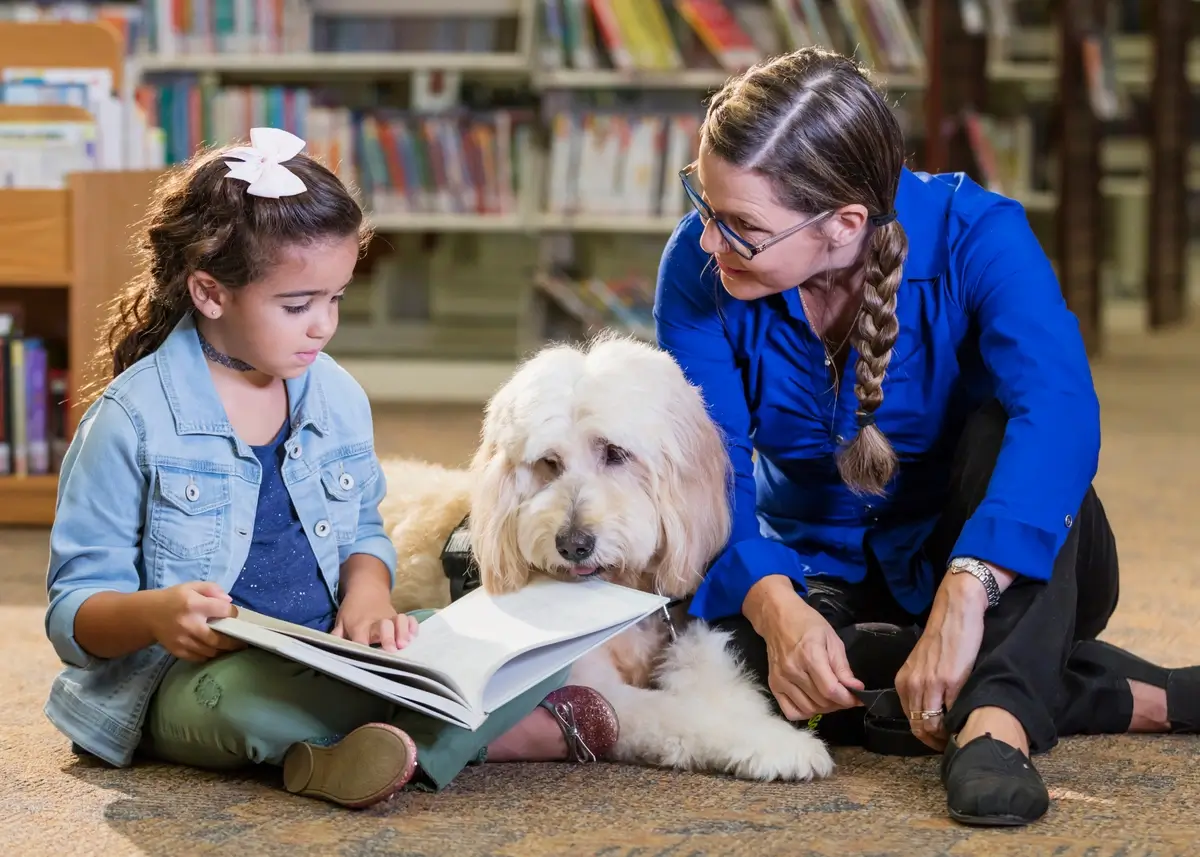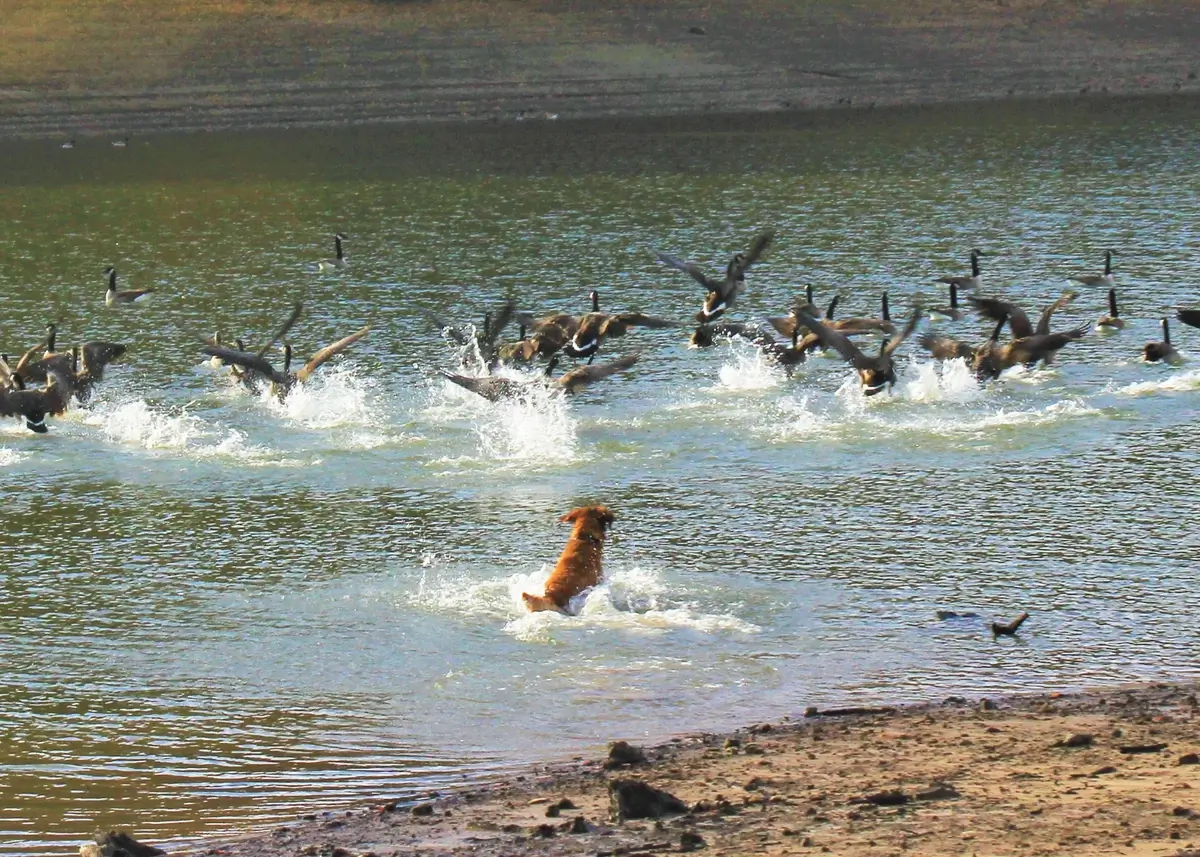Throughout the centuries, humans have domesticated and designed certain dog breeds to perform specific jobs to benefit humans. Humans have used dogs’ natural instincts and genetics to develop four-legged assistance for all sorts of tasks. Today, you’ll find dogs that have historically had helpful duties make great family pets.
You’ve probably seen working dogs in action and are familiar with the types of dog breeds that perform specialized tasks and services. For example, you may recognize that Labrador Retrievers and other dog breeds are common guide dogs for the visually impaired. They usually have a designated harness and vest stating a message like “Working dog – do not pet” on it to let you know they’re on the clock! You see them assisting their owners in various ways to help them navigate through society.
You’ve also probably met an emotional support dog that provides comfort and reassurance for its owner. We’ve all seen German Shepherds in K-9 units responding to situations where police are called and images on TV of search and rescue dogs helping during emergency situations. You may think of Border Collies rounding up sheep or Beagles chasing foxes through the English countryside.
These jobs are common in our society, and most people are familiar with what the aforementioned dog jobs entail. However, there may be dog professions out there you have never even heard of! Learn what qualities working dogs share and discover some of the more unusual dog jobs our canine friends have.
What Type of Dog Makes a Great Dog Job Candidate?
In a perfect world, we would all like to think our dogs are totally obedient, ready to be at our beck and call. However, we live in reality and know that it takes a special dog to be able to remember specialized training and work on command.
Some dogs are raised from birth to do their specific jobs, while others may stumble into their professions, discovering their strengths along the way. Regardless, not just any dog can walk in and ask for a doggy application for an after-school job. The key is knowing the dog’s personality combined with utilizing its natural talents to find the best dog job to suit him or her.
There is no one-size-fits-all perfect size all working dogs must be. Size is just one of the many factors that determine the best job for a dog. It’s not the size of the dog, but the size of its heart! All the dog professions we feature come in a range of shapes and sizes. Some dogs’ only motivation is to win the “Biggest Couch Potato” trophy. They balk at simple commands and have their own agenda of basking in the sunshine and being lazy. They may be the “right” breed but have the opposite personality of what their breed is known for, and that’s okay! Not every dog needs a job.
However, several hardworking dog breeds and mixes make great dog job candidates for canine professions. Regardless of the type of dog, a great working dog with a job will inevitably share several characteristics, including being:
- Patient
- Intelligent
- High-energy
- Easy to train
- Eager to please
- A member of certain groups such as working, sporting, or hunting dogs
Why Does a Dog Need a Job?
What happens when a dog doesn’t have a job? Not honoring a dog’s need for physical exercise and canine mental stimulation can greatly harm a dog and develop severe behavioral problems such as destructive behavior, hyperactivity, and separation anxiety.
Some dogs were historically bred (and still are) for extremely specific jobs. If you take a dog and put it in an environment not conducive to its natural instincts, problems are guaranteed to arise. For example, keeping a Siberian Husky puppy in a small high-rise condo in Miami without exercising it properly is definitely a recipe for disaster unless special attention is paid to maintaining a cold-weather breed in the Florida heat in a small space without a yard – not to mention that Huskies like to “tell” you (and the whole building) all about their feelings!
Not providing an outlet for herding or livestock dogs like Border Collies, Australian Shepherds, or Australian Cattle Dog/Blue Heelers might cause them to start herding children and nipping at their feet to keep them in line. A dog bred for scent work requiring lots of room to roam that hardly ever gets to explore outside such as a German Shorthaired Pointer or Bloodhound might escape a fenced-in yard and follow its nose to find its prey. It’s not being naughty on purpose – it’s just doing its job!
The behavior itself becomes a problem when the dog is not in an environment catered to its needs, which is why a job is so important to give to the dog. Many times the problem is not with the dog itself but with the owner’s ignorance of how to provide opportunities the dog requires to thrive. Unfortunately, not matching the dog to the right environment can end up with an owner surrendering the dog to a shelter.
Does a Working Dog Need Special Treatment?
While all dogs are man’s best friend, a working dog will need extra attention to ensure they’re happy and healthy to perform their job to the best of their abilities.
Health requirements
Regardless of the job, all working dogs need humans to take care of their health first and foremost. They will usually need more rest time and health checks than a dog without a specific job due to the nature of their professions.
A dog whose job requires traversing unsteady terrain in all sorts of weather conditions will need to have its paws examined more frequently and may require special salve or balm as preventative measures to avoid frostbitten, chapped or cut paws. A herding dog, a wildlife shepherd, or a dog that checks for invasive species such as venomous snakes and spiders will need more full body checks for bites, ticks, and scratches. Extremely active dogs will need to have their muscles, skeleton health, and joints checked more frequently.
Specialized training
Every single working dog will need specialized training that goes way beyond basic commands. Some of these training regiments last years to ensure time to learn all the skills needed for the job, nail down perfect recall and obedience, and practice real-world situations before becoming fully “on the clock.”
Nutritional needs
The nutritional needs of working dogs will vary depending on how they require and expend energy. For example, sled dogs will need way more high-protein, calorie-dense food choices because they are used to hauling heavy loads for hours and need enough fuel for stamina, strength, and endurance. In contrast, a dog with a less physically demanding job will be fine with a regular high-quality dog diet.
Rest and recuperation
Some dogs can work long hours in extremely dangerous and unstable conditions, such as search and rescue jobs during disasters and under the threat of poachers in the wilderness. These dogs will need more rest and recuperation than a dog with less strenuous working conditions.
Equipment
Different professions come with a specific set of tools to help dogs do their jobs properly. A reading therapy dog will only need its human to hang up a light vest, whereas a search and rescue dog may be wearing protective booties, a helmet with a headlamp, a backpack of supplies, and a heavy-duty protective vest – obviously, a heavier load than a low-key dog job requires.
Optimal living conditions
Working dogs can live in a variety of conditions as well. Not every dog prefers to be curled up in a ball in front of a roaring fire after a long day. Livestock and cold weather dog breeds love to be outdoors. They are totally fine sleeping outside in a shelter with some warm hay while it's snowing. Their thick, waterproof double coat provides natural protection from the elements and keeps them warm and cool depending on the weather. For other dogs, they’d absolutely need to sleep indoors as part of the family.
Grooming
The grooming needs of working dogs can range from a hands-off approach to frequent trips to the groomer. A therapy dog that visits hospitals and children and mainly stays indoors must stay impeccably groomed, whereas it is not a big deal if your livestock dog constantly has muddy paws and bits of straw and grass stuck in his fur. They might need coat checks here and there but will not need to look show-ready to round up those sheep!
Societal & legal protection
Working dogs have layers of protection built into society to defend them and promote their working and living conditions. Several laws and regulations exist to protect the welfare of working dogs and the humans they help. For example, the Americans with Disabilities Act service dog requirements define what a service dog is and where it can go to assist its human. Scientists are constantly conducting animal welfare research regarding ethical concerns, evaluating optimal working conditions, monitoring stress, and determining the best ways to care for working dogs.
15 Unusual Dog Jobs You May Not Have Heard Of
In addition to the more familiar dog jobs like guiding, herding, and search and rescue, here are some dog jobs you might not have ever heard of or considered to be necessary until now. While not a comprehensive list of all dog jobs out there, here are enough dog employment opportunities to get your puppy one paw in the door when pounding the pavement.
1. Comfort provider
Nursing homes, schools, courts, and hospitals all benefit from comfort therapy dogs. Their only job is to bring happiness and cheer to humans – what a wonderful job to have! These dogs can also be deployed in times of crisis, such as school shootings or natural disasters. They are trained specifically to help people remain calm in stressful environments. Both crisis response & comfort therapy dogs can help encourage physical and mental healing in tough times.
2. Reading buddy
You may have heard of pairing up older students with younger ones to help them practice reading, but did you know dogs have become canine reading buddies? These patient dogs help kids practice reading skills, build confidence, and provide an added layer of a trained handler to help when needed.
3. Prison dog programs
Eligible incarcerated people can work with dogs in a variety of rehabilitation or training opportunities and programs. Prison inmates can help train puppies with basic commands, leash walking, housebreaking, and socialization. Some programs train dogs for specific purposes such as service dogs for disabled veterans. While the dog receives crucial training, the incarcerated person also experiences benefits such as lowering the chance of reincarceration, improving mental and behavioral health, and giving a sense of purpose.
4. Acting star
We’re all familiar with classic movies and shows featuring dogs like Homeward Bound, Annie, Lassie, Turner & Hooch, Benji, the Sandlot, Bolt, Beethoven, Air Buddies, and many more. Dogs with acting abilities are highly trained to perform hundreds of tricks on command, learn quickly, and are eager to please. Several associations exist to create guidelines and monitor the welfare of animals during production. The “No Animals Were Harmed” program of American Humane is committed to ensuring the safety, welfare, and well-being of animals on set.
5. Border patrol investigator
Dogs serving as border patrol investigators turn their attention beyond just human activity when keeping borders secure. Trained dogs at various ports of entry both land and sea can detect invasive species that try to enter the nation like certain types of plants, snakes, spiders, food, drugs, and other items that can threaten national security and integrity.
6. Wildlife shepherd
Dog breeds that make great livestock guardians and shepherds don’t tend to just domesticated livestock – they can also be useful in the wilderness. A Border Collie nicknamed “Bark Ranger Gracie” is one of the first dogs to be employed by the National Park Service and is tasked with keeping wildlife and visitors at Glacier National Park a safe distance apart by moving out herds of mountain goats, deer, and bighorn sheep and deterring the presence of mountain lions.
7. Police, military, and protection dogs
Many people think of images filled with sharp teeth and growling dogs, but dogs serving as police, military, or protection canines are trained in much more than intimidation. These dogs are taught to combat a specific threat by biting, holding, and releasing, not with an attack command. These dogs can also track explosives and bombs and serve in evidence recovery events.
8. Poacher catchers
Anti-poaching units in Africa have trained dogs to detect the scent of poachers and illegal products. Hunting endangered and protected species is against the law, and dogs help lead the way in keeping these animals safe.
9. Lifeguard and water rescue
While doggy paddling in humans is considered a basic way of swimming, doggy paddling by, well, dogs can actually save lives! Dogs trained as lifeguards and in water rescue help patrol recreational areas on lakes, beaches, and rivers and can also be used in swift water rescue situations. Breeds that are strong swimmers such as Newfoundlands, Golden Retrievers, and other water-loving dogs are great choices for lifeguard and water rescue.
10. Endangered species locator
Taking inspiration from narcotic canine programs, dogs can be trained to assist conservationists to locate and help threatened and endangered species. In fact, their training can be so specialized that these dogs can identify over 13 different species of animals by smelling their scat, including:
- Spotted Owl
- Caribou
- Cougar
- Tiger
- Giant Armadillo
- Iberian Wolf
11. Bird “traffic” controller
Birds are fun to look at sometimes, but they can be a huge nuisance to places and businesses with large amounts of open space. Birds colliding with airplanes and clogging the runways can cause serious problems, and geese leave waste everywhere while destroying golf courses. A dog serving as a bird traffic controller chases birds off properties to keep the planes on track, the links open to flying golf balls, and reduces property destruction.
12. Truffle sniffer
The Lagotto Romano is a breed that has deep roots in truffle hunting. Their incredible sense of smell can sniff out truffles, a lucrative reward. Another positive aspect of a truffle hunting dog like a Lagotto Romano is they can be trained not to bark when they find these tasty morsels, therefore not giving away your secret find.
Other easy-to-train, super-sniffing breeds that make great truffle hunters are Border Collies, Belgian Malinois, Beagles, and English Springer Spaniels.
13. Puffin hunter
The Norwegian Lundehund, also known as Norsk Lundehund and the Norwegian Puffin Dog, is one of the rarest dog breeds in the world with only around 1,400 dogs remaining, mostly in Norway and the United States. This small Spitz-like dog is from the island of Vaeroy just off the coast of Norway. The Norwegian Lundehund breed had since the Viking era to perfect its specialty – hunting puffins. It even has an extra 6th toe to improve grip on slippery, steep cliffs.
14. Water sniffer
You’ve heard of Beagles catching the scent of a fox, but did you know dogs can also detect water underground using their noses? Agencies have started using water sniffer dogs to search for underground water sources which give off chlorine when it degasses. Water sniffer dogs can even tell the difference between treated water and groundwater. The dog can pick up the scent of chlorine and lies down on the spot.
15. Medical detector
In addition to being guide dogs, canines can assist people with a variety of medical issues. Using a keen sense of smell, the canine olfactory system can detect a seizure up to 45 minutes before it happens. They can also detect significant blood sugar changes in people with diabetes and find certain types of cancer due to changes in body chemistry found in sweat, urine, and skin. Standard Poodles, various types of retrievers, and other breeds make excellent medical detection dogs.
Give a Pawrade Dog a Job
If you want to take a role beyond a casual dog-owner relationship, consider giving Pawrade puppies for sale a dog job! We have all sorts of breeds that are fantastic for a variety of jobs and thrive with specialized training to help humans in all sorts of ways. Contact us today!






